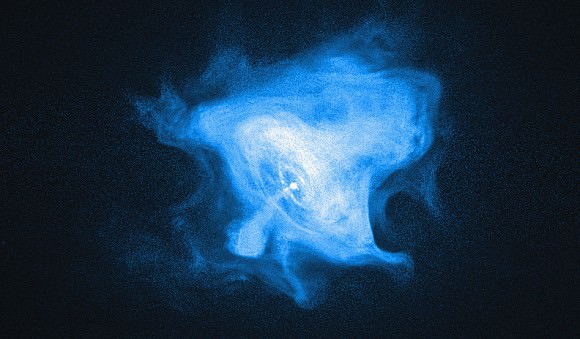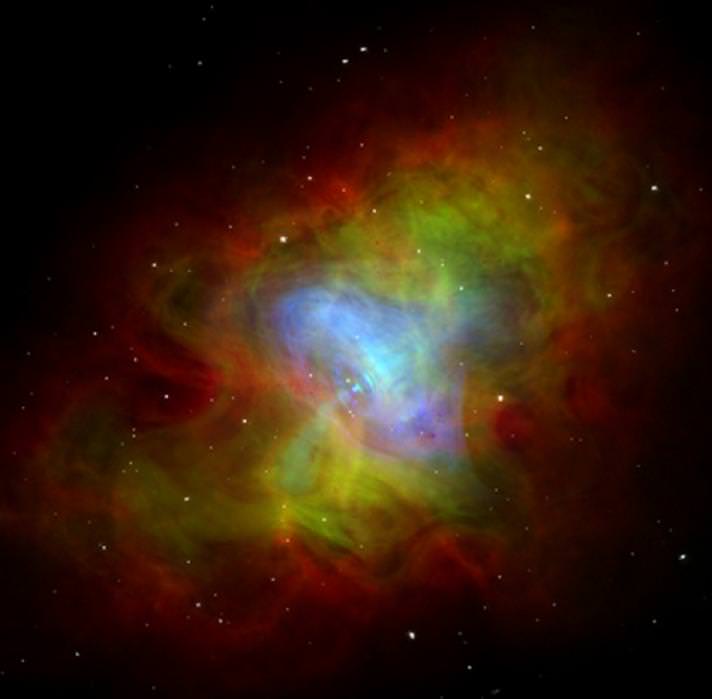[/caption]
It’s one of the most famous sights in the night sky… and 957 years ago it was bright enough to be seen during the day. This supernova event was one of the most spectacular of its kind and it still delights, amazes and even surprises astronomers to this day. Think there’s nothing new to know about M1? Then think again…
An international collaboration of astrophysicists, including a group from the Department of Physics in Arts & Sciences at Washington University in St. Louis, has detected pulsed gamma rays coming from the heart of the “Crab”. Apparently the central neutron star is putting off energies that can’t quite be explained. These pulses between range 100 and 400 billion electronvolts (Gigaelectronvolts, or GeV), far higher than 25 GeV, the most energetic radiation recorded. To give you an example, a 400 GeV photon is almost a trillion times more energetic than a light photon.
“This is the first time very-high-energy gamma rays have been detected from a pulsar – a rapidly spinning neutron star about the size of the city of Ames but with a mass greater than that of the Sun,” said Frank Krennrich, an Iowa State professor of physics and astronomy and a co-author of the paper.
We can thank the Arizona based Very Energetic Radiation Imaging Telescope Array System (VERITAS) array of four 12-meter Cherenkov telescopes covered in 350 mirrors for the findings. It is continually monitoring Earth’s atmosphere for the fleeting signals of gamma-ray radiation. However, findings like these on such a well-known object is nearly unprecedented.
“We presented the results at a conference and the entire community was stunned,” says Henric Krawczynski, PhD, professor of physics at Washington University. The WUSTL group led by James H. Buckley, PhD, professor of physics, and Krawczynski is one of six founding members of the VERITAS consortium.

We know the Crab’s story and how its pulsar sweeps around like a lighthouse… But Krennrich said such high energies can’t be explained by the current understanding of pulsars. Not even curvature radiation can be at the root of these gamma-ray emissions.
“The pulsar in the center of the nebula had been seen in radio, optical, X-ray and soft gamma-ray wavelengths,” says Matthias Beilicke, PhD, research assistant professor of physics at Washington University. “But we didn’t think it was radiating pulsed emissions above 100 GeV. VERITAS can observe gamma-rays between100 GeV and 30 trillion electronvolts (Teraelectronvolts or TeV).”
Just enough to cook one crab… well done!
Original Story Source: Iowa State University News Release. For Further Reading: Washington University in St. Louis News Release.


I am worried about the swirly detail in the image. This looks like some artefact from a de-noising program. I have written some of these, and I have got similar results if you turn the adaptive smoothing up too high. Here’s another Chandra image which looks more genuine…
http://chandra.harvard.edu/photo/1999/0052/
Anyway, it’s still a great picture.
A recent paper posted on the arxiv servers examined the (off center) geometry a feature that may represent a termination shock front very close to the Crab pulsar: http://arxiv.org/ftp/arxiv/papers/1109/1109.2868.pdf
This ring would lie about ~10 light-days distant from the pulsar, assuming a distance of 2kpc to the Crab Nebula.
Tammy, those references were very good, especially the 2nd link where the current models finally have a decent graph, and I learned about the sphere or rather cylinder of influence (light cylinder) around a pulsar. That helps us laymen immensely.
On the nitpicky side I was confused to read about “the most energetic radiation recorded.” The later context puts that as around pulsars, but I had to visit the refs to be sure.
[As a larger context, I found this reference through Wikipedia, that claims that ~ 1 TeV emissions with up to ~ 10 TeV spectra has been observed.]
Tammy, those references were very good, especially the 2nd link where the current models finally have a decent graph, and I learned about the sphere or rather cylinder of influence (light cylinder) around a pulsar. That helps us laymen immensely.
On the nitpicky side I was confused to read about “the most energetic radiation recorded.” The later context puts that as around pulsars, but I had to visit the refs to be sure.
[As a larger context, I found this reference through Wikipedia, that claims that ~ 1 TeV emissions with up to ~ 10 TeV spectra has been observed.]